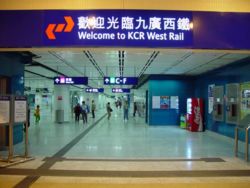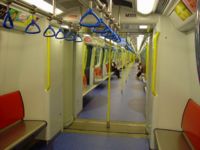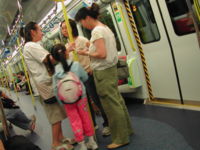KCR West Rail
|
| ||
| Opening Date | 20 December 2003 | |
| Stations | 9 | |
| Number of trains | 23 | |
| Service Area | Tuen Mun, Yuen Long, Tsuen Wan, Sham Shui Po | |
The West Rail is one of the three lines of the KCR network in Hong Kong. It starts at Nam Cheong station in Sham Shui Po and ends at Tuen Mun station in Tuen Mun.
Currently the West Rail provides local service on its own. No inter-city service is offered, making it effectively more like a metro instead of a commuter railway, although it was built in commuter railway standard, and was expected to accommodate other trains in future.
Contents
History
A railway to the northwestern New Territories from the urban area in Kowloon was proposed in the early 1990s. Both the MTR and the KCRC submitted plans to the government, but finally the KCRC's proposal to Tin Shui Wai new town was selected. However, several major accidents on Tuen Mun Road made residents in Tuen Mun request a railway connection within the centre of the new town of Tuen Mun. This made the route in the final decision deviate from the original plan (which terminated at the centre of Tin Shui Wai new town), terminating near Tuen Mun Town Centre.
The first phase of construction included a double-track commuter railway connecting Tuen Mun station and Nam Cheong stations. This system has been in operation since December 20 2003.
Property of the Railway
The track for the West Rail was laid underground only between Mei Foo and Kam Sheung Road stations. North of Kam Sheung Road station, the track emerges to the surface, and there is a depot between the tunnel portion and the station. The train is actually at ground level south of Mei Foo station, but the covered tracks makes most passengers feel like they are travelling underground. The rest of the line was built on a viaduct, which was constructed so that there is room for an emergency passage.
Situations when the Railway first opened
Originally, the KCRC expected to have around 120,000 passengers use the line every day, but
unsatisfactory connections between stations and the areas they serve meant that the number of commuters choosing to use the West Rail remained far short of the goal after opening. The KCRC was also blamed for its route planning and forceful reduction of bus service, which had mainly been provided by Kowloon Motor Bus after operation.
Furthermore, due to the frequent breakdowns, the chairman of KCRC, Michael Tien, announced that if the performance of West Rail did not improve, he would have considered resigning. Although "one-month passes" were introduced on August 1 2004, and the daily ridership increased to 150,000, there was still a long way to go before the KCRC's goal of 200,000 passengers was met.
Michael Tien announced that a further discount of 20% would be cancelled due to quick recovery of the economy and a ridership increase to 170,000, but the "one-month pass" concession would be extended for a half year. The new faretable became effective on December 20, 2004. If there is a drastic decrease of passenger capacity in the future, other promotions may be started. However Tien claimed that the probability of this happening would be low.
Future expansions
The West Rail will be extended both to the south and north in the future. A new branch will go from Kam Sheung Road to Lok Ma Chau, and to Sheung Shui via Chau Tau. The southern link will be an extension from Nam Cheong station to the East Rail Hung Hom station via East Tsim Sha Tsui with an intermediate station to be called West Kowloon located east of Kowloon station on the Airport Express.
There are suggestions to use the tracks of the West Rail to accommodate the future Regional Express to Guangzhou via Shenzhen.
Stations
This is a list of all the stations on West Rail. The coloured boxes holding the station names represent the unique colour motif for the station.
Template:KCR West Rail stations
Notes
* Proposed
# Under construction
1 West Kowloon is the station on the proposed Kowloon Southern Link. It is an extension of the KCR West Rail designed to link up to the KCR East Rail at Hung Hom Station. Upon completion of the link, East Tsim Sha Tsui station, currently serving only the East Rail, will also serve the West Rail.
2 Tsuen Wan West KCR station and Tsuen Wan MTR station (Tsuen Wan Line) are not physically linked. However, green minibus route 95K is provided between the two stations (free transfer with an immediate West Rail journey record on the Octopus card). Journey time is 15-20 minutes Tsuen Wan Station on foot.
3 KCR intends to expand Kam Sheung Road Station in the future, to act as an interchange station between the West Rail main line and the Northern Link extension. For the time being, Kam Sheung Road is a plain through-station without any interchange facilities.
Improvement solution of signalling system
In August 2005, Michael Tien announced that 90% of breakdowns of the signalling system are due to failure of axle counters. 45% of the whole line is elevated, which makes power lines easier to be hit by lightning, therefore causing such breakdowns. The average distance between two stations is 3 km, which results in a longer time for engineers to repair the signalling system. The most serious breakdown happened on July 21 2005 and caused a delay of up to 40 minutes, which exceeds the total journey time of 30 minutes.
For this reason, KCRC decided to throw over HK$10M to improve the signalling system, including hiring foreign railway experts and finding solutions to decrease the down-time.
Major incidents
At 09:15 on February 14 2007, a passenger train broke down when one of the transformers mounted on the train roof exploded. It is suspected that the overheated transformer caused its insulating oil to vapourize, thus causing the explosion. In addition, the circuit breaker of the transformer apparently failed to cut the power supply to the transformer.
The scene was in a tunnel on the southbound section between Kam Sheung Road to Tsuen Wan West, about 2 km from Tsuen Wan West. Around 650 passengers had to evacuate through the dark tunnel to the station, and around 340 people returned to the ground through a ventilation shaft at Chai Wan Kok. Eleven people were sent to hospital. Train services returned normal after 4 hours[1].
References
- ↑ Cheng, Jonathan (February 15, 2007). KCRC in pledge on safety. Hong Kong Standard. Retrieved on 2007-01-30.
See also
External links
| Rapid transit in China |
|---|
| Beijing Subway • Chongqing Metro • Guangzhou Metro • Hong Kong MTR • Kowloon-Canton Railway • Nanjing Metro • Shanghai Metro • Shenzhen Metro • Tianjin Metro • Wuhan Metro
Under construction |



